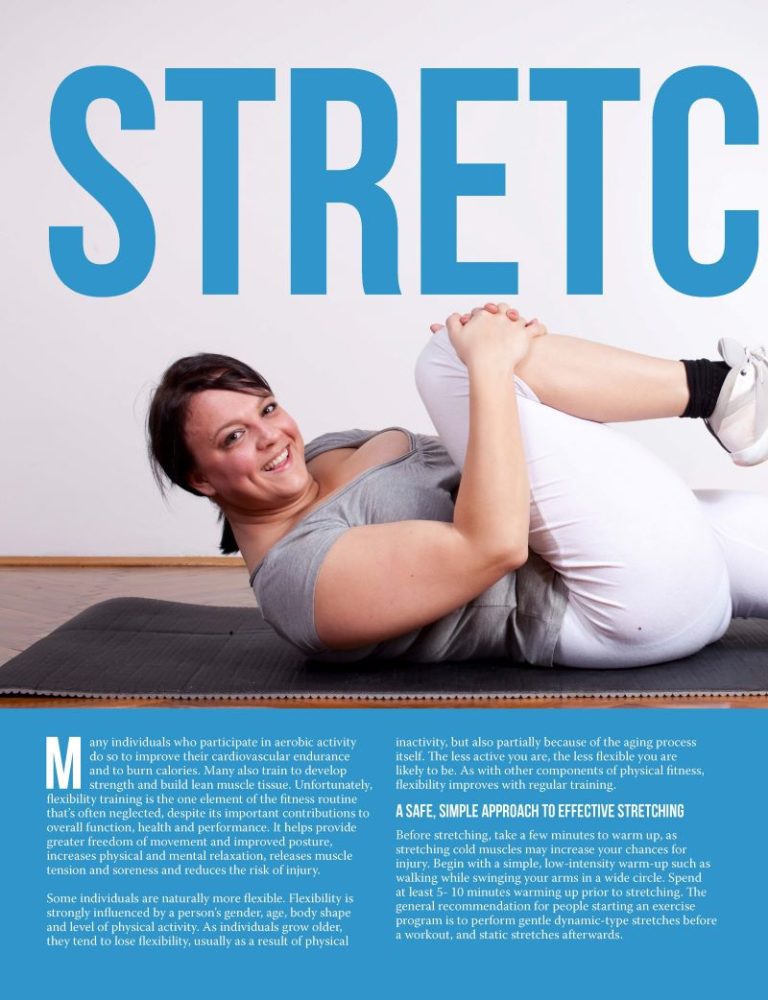Exercise: Stretching – An Integral Part of Your Fitness Routine


by Cedric X. Bryant, PhD, FACSM
Fall 2015
Many individuals who participate in aerobic activity do so to improve their cardiovascular endurance and to burn calories. Many also train to develop strength and build lean muscle tissue. Unfortunately, flexibility training is the one element of the fitness routine that’s often neglected, despite its important contributions to overall function, health and performance. It helps provide greater freedom of movement and improved posture, increases physical and mental relaxation, releases muscle tension and soreness and reduces the risk of injury.
Some individuals are naturally more flexible. Flexibility is strongly influenced by a person’s gender, age, body shape and level of physical activity. As individuals grow older, they tend to lose flexibility, usually as a result of physical inactivity, but also partially because of the aging process itself. The less active you are, the less flexible you are likely to be. As with other components of physical fitness, flexibility improves with regular training.
A Safe, Simple Approach to Effective Stretching
Before stretching, take a few minutes to warm up, as stretching cold muscles may increase your chances for injury. Begin with a simple, low-intensity warm-up such as walking while swinging your arms in a wide circle. Spend at least 5- 10 minutes warming up prior to stretching. The general recommendation for people starting an exercise program is to perform gentle dynamic-type stretches before a workout, and static stretches afterwards.
When performing a static stretch:
- Take a deep breath and slowly exhale as you gently stretch the muscle to a point of tension.
- Hold the stretch for 15-30 seconds, relax and then repeat the stretch two to four more times.
- Don’t bounce a stretch. Holding a stretch is more effective and there is less risk of injury.
- Don’t stretch a muscle that is not warmed up.
- Don’t strain or push a muscle too far. If a stretch hurts, ease up.
- Don’t hold your breath during the stretch; continue to breathe normally.
The following stretches are easy to implement from anywhere and target the muscles that need lengthening throughout the day.
Side Neck Stretch
Benefit: Helps relieve tension in the muscles of the neck and jaw.
How to Perform: Slowly tilt your left ear toward your shoulder. Place the top of your right hand on the lower part of your back, and roll your right shoulder down and away from your ear. Place your left hand with slight pressure on the top of your head. Slightly lift your chin and keep your jaw open. Hold for five deep breaths, release and repeat on the opposite side.
Seated Figure Four Stretch
Benefit: Helps relieve tension in the muscles of the hips and buttocks.
How to Perform: Sit upright with a neutral spine. Cross your right leg over your left and rest your hands on your shins. For a deeper stretch, lean your torso slightly forward. Hold for five deep breaths, release and repeat on your left leg.
Seated Lateral Stretch
Benefit: Helps relieve tension in the muscles of the upper and mid-back region.
How to Perform: Sit upright with your feet firmly planted on the ground. Keep your spine neutral and place hands interlocked behind your head. Hold and allow your chest to open for three breaths while your elbows open to the side. Exhale, and laterally flex the spine on your left side (imagine the left side of your rib cage moves closer to your hip bone). Hold for five deep breaths, return to center and repeat on the opposite side.
Downward Facing Dog with Chair
Benefit: Helps relieve tension in the muscles of the chest and back of the legs.
How to Perform: Stand upright and walk your feet slightly in front of your hips. Hinge at your hips and place your hands on your chair or door handle. Push your hips back as you bring your chest parallel to the floor. Hold for five deep breaths.
Seated Spinal Twist
Benefit: Helps relieve tension in the spinal extensor muscles to contribute to improved posture and reduced back pain.
How to Perform: Sit upright with feet flat on the floor. Cross your right leg over your left (if this is too deep, keep feet on the floor). Inhale, lift your arms overhead and exhale. Rotate to your right and place your hands on the outside of your chair or thigh. Hold for five breaths. Inhale, rotate to your center, switch your crossed legs and exhale, then complete the stretch on your left.
About the Author:
As Chief Science Officer at the American Council on Exercise, Cedric X. Bryant, PhD, FACSM, is a National and international lecturer, writer and member of the National Academy of Medicine’s Obesity Solutions Roundtable. Bryant is also a subject-matter expert and stays at the forefront of applied physiological research, exercise training methods and health and fitness trends.
by Yelena Kibasova Spring 2024 The fitness world is evolving, with new trends and innovations that promise…
Read Articleby Zack Lucks, NASM-CPT, EMT Winter 2024 Working out with a loved one is a great way…
Read Articleby Nina Crowley, PhD, RD (with Inspiration from Shawn Cochran) Winter 2024 Dating, no matter your age,…
Read Article









